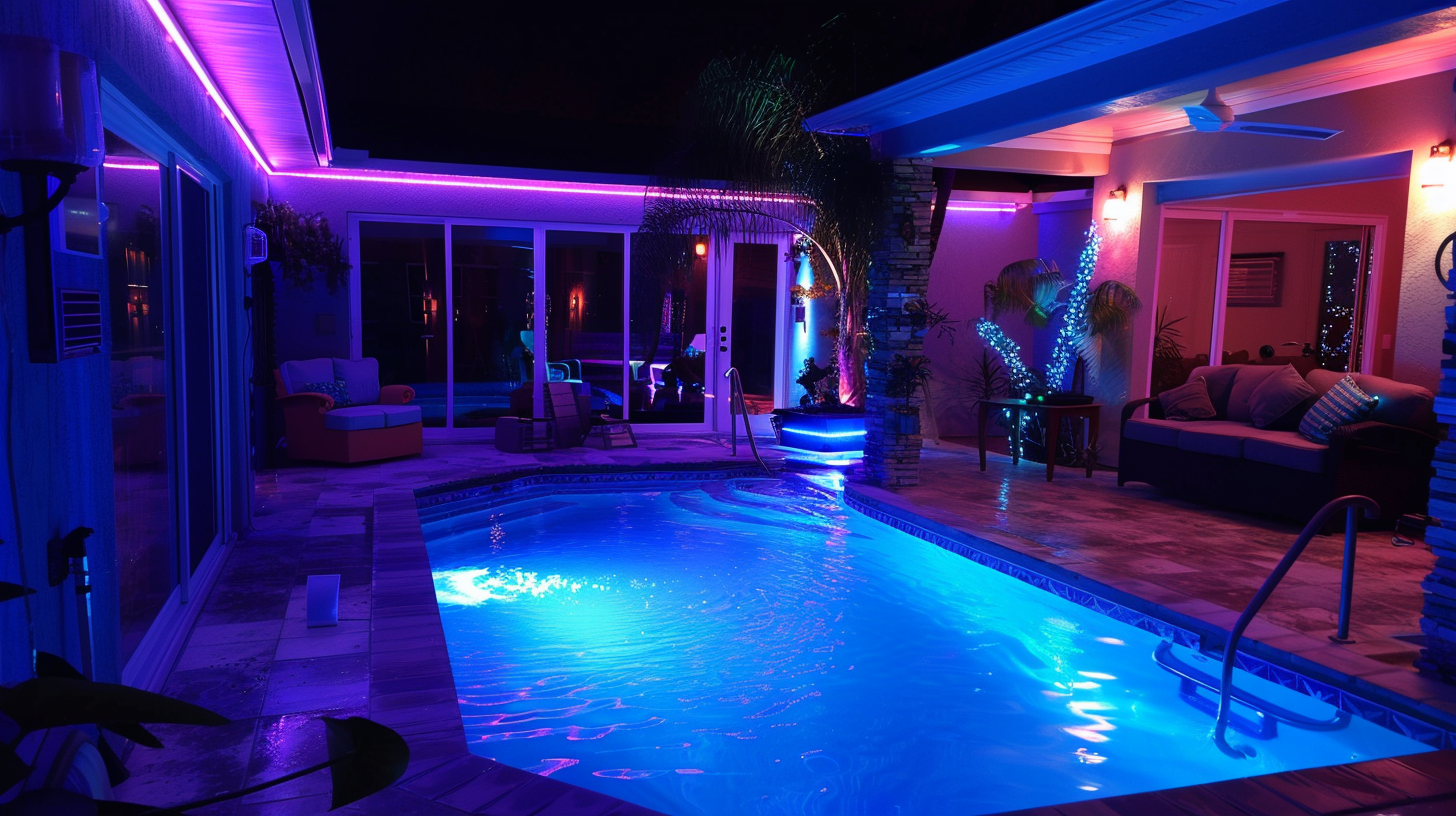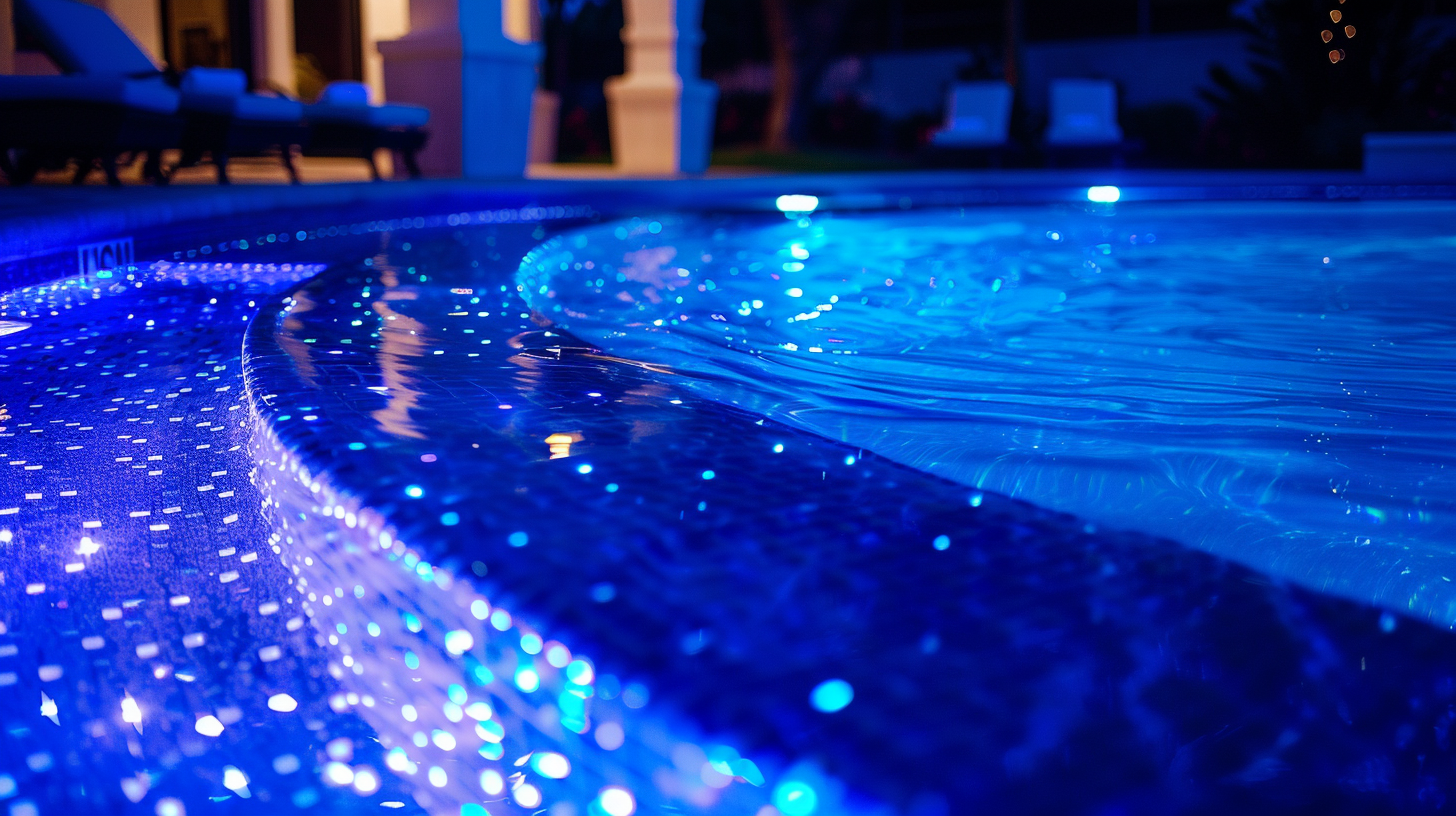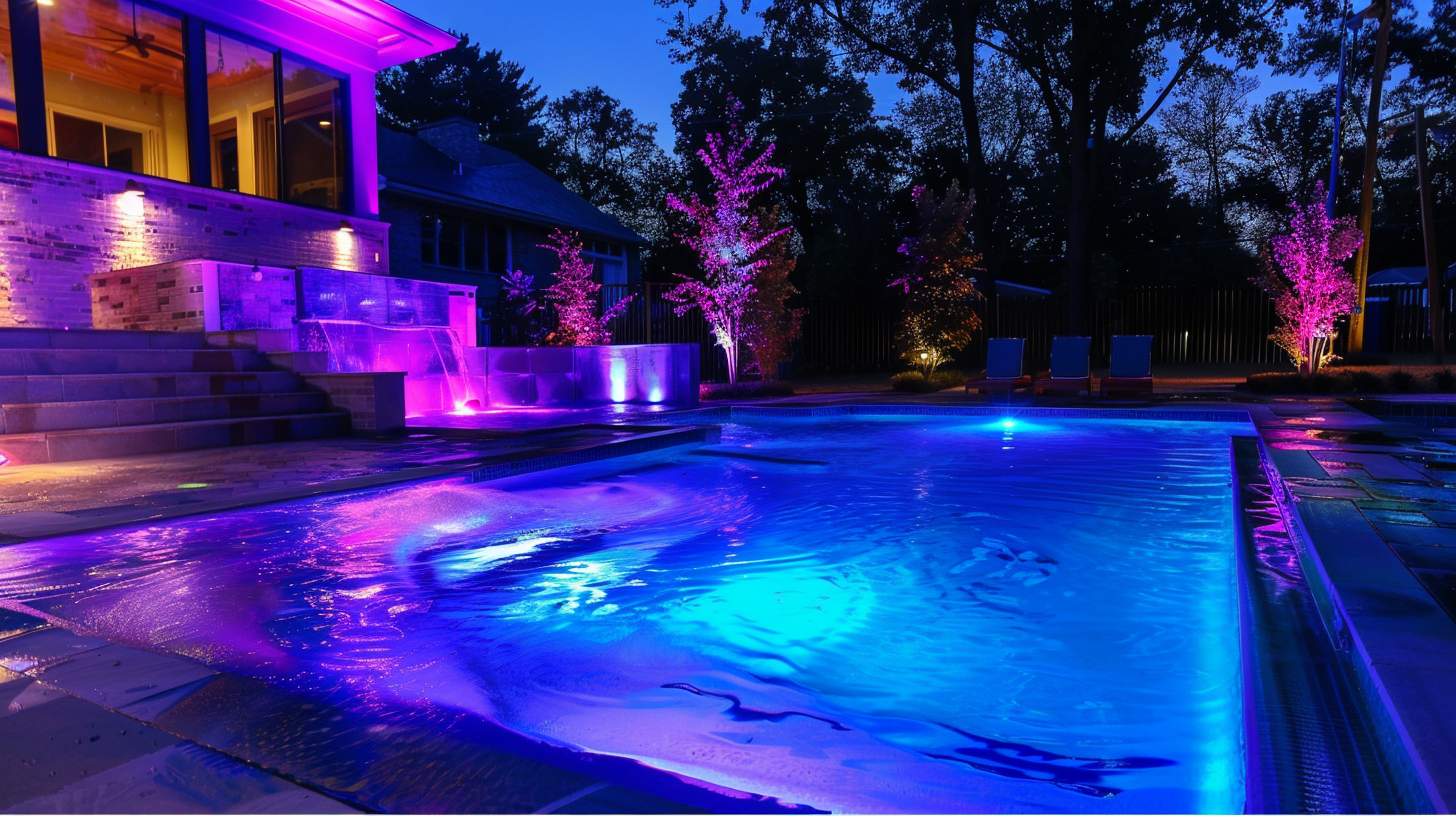Incandescent vs. LED underwater pool lights
When it comes to illuminating your pool, understanding the basics of light technology can help you make an informed choice between incandescent and LED pool lights. Incandescent lights have been around for over a century and work by passing an electric current through a thin filament, which then heats up and emits light. While this tried-and-true technology provides a warm and classic glow, it is not without its downsides.
On the other hand, LED (Light Emitting Diode) technology represents a more modern approach to lighting. Instead of relying on heat to produce light, LEDs use a semiconductor to emit light when an electric current passes through it. This results in LED pool lights being far more energy-efficient and long-lasting compared to their incandescent counterparts.
Moreover, LED lights offer greater versatility. Available in a variety of colors and programmable settings, they can create stunning lighting effects that can transform the ambiance of your pool area. Whether you want a calming blue for a relaxing evening swim or a vibrant multicolored display for a pool party, LEDs can easily cater to your needs.
Understanding the differences between these two technologies can help you choose the right lighting solution for your pool. While incandescent lights have a charming glow, the advantages of LED lights in terms of efficiency, lifespan, and versatility make them a compelling option worth considering.
Energy efficiency comparison
When it comes to energy efficiency, the differences between incandescent and LED pool lights are substantial. Incandescent lights are notorious for being energy hogs. These lights convert only about 10% of the electrical energy they consume into light; the remaining 90% is lost as heat. This inefficiency results in higher electricity bills and increased energy consumption, which is not ideal for eco-conscious pool owners.
In stark contrast, LED pool lights are champions of energy efficiency. LEDs convert around 80-90% of their energy directly into light, minimizing wasted energy. This efficiency not only translates to lower energy costs but also means that these lights are better for the environment. For instance, an LED pool light that uses just 30 watts of power can produce as much light as a 200-watt incandescent bulb. Imagine the reduction in your energy bills over the long run!
Furthermore, LED lights often come with programmable features, allowing for even more energy savings. You can set timers or use remote controls to turn them on only when needed, maximizing their efficiency. This smart use of electricity is something you won’t get with incandescent lights, which are either on or off, with no room for nuanced control.
While the initial investment in LED pool lights might be higher, the energy savings over time easily make up for the cost difference. These energy savings are not just financial; they also translate into a smaller carbon footprint. By choosing LEDs, you are adopting a more sustainable lifestyle, contributing to energy conservation and environmental protection.
So, when comparing the energy efficiency of incandescent and LED pool lights, it’s clear that LEDs are the frontrunners. They offer a compelling mix of cost savings, environmental benefits, and user-friendly features that make them the superior choice for any modern pool area.
Cost analysis and lifespan
When evaluating the cost implications and lifespan of incandescent and LED underwater pool lights, substantial differences become evident. Incandescent pool lights, although initially less expensive, have a significantly shorter lifespan. Typically, an incandescent bulb may last anywhere from 1,000 to 2,000 hours before it needs replacement. This relatively short lifetime means you’ll find yourself frequently replacing these bulbs, which can add up in both material costs and maintenance labor over time.
In stark contrast, LED pool lights boast an impressive operational lifespan, often between 30,000 to 50,000 hours. This longevity is a direct result of the efficient technology that LEDs employ, generating minimal heat compared to incandescent bulbs, which not only waste energy but also degrade faster due to overheating. Consequently, the infrequent need for replacements can result in significant long-term savings, making LEDs a more cost-effective choice in the long run despite their higher initial purchase price.
Additionally, maintenance costs play a critical role in the overall expenditure. With incandescent lights, the frequent need for bulb replacements means increased maintenance efforts and costs. This is especially pertinent in an underwater setting, where replacing a light is more cumbersome than in typical environments. Each time an incandescent bulb needs to be changed, the pool may require partial draining or specialized equipment to ensure a safe replacement, all of which add to the total cost.
LED pool lights, with their extensive lifespan, considerably reduce the need for such frequent maintenance interventions. This reduction not only saves money but also spares pool owners from the inconvenience of repeated replacements, allowing for more uninterrupted enjoyment of their illuminated pools.
Moreover, many LED lights are integrated into fully sealed, waterproof fixtures that enhance their durability even further. These fixtures are designed to withstand harsh pool chemicals and varying water temperatures, ensuring consistent performance over many years. This durability translates to fewer replacements, less labor, and lower overall maintenance costs.
Considering the lifecycle costs, it’s clear that LED pool lights emerge as a more economically wise option over incandescent lights. While the higher upfront cost of LED lights might initially deter some pool owners, the aggregate savings in energy, replacements, and maintenance make them a far more cost-effective solution in the long term. Besides the financial benefits, the extended lifespan and reduced maintenance efforts contribute significantly to a hassle-free pool lighting experience, allowing you to focus more on relaxation and less on upkeep.
Performance and brightness
LED underwater pool lights offer remarkable performance and brightness that far surpasses that of incandescent lights. LEDs come equipped with high lumens output per watt, making them exceptionally bright while still being energy-efficient. When illuminated underwater, LED lights deliver a clear, crisp, and vibrant illumination that enhances the visual appeal of the pool area, making night swimming safer and more enjoyable.
One of the standout features of LED pool lights is their ability to produce a wide spectrum of colors without the need for additional filters. Modern LED pool lights are often equipped with color-changing capabilities, allowing users to cycle through a range of colors and create customized lighting effects. This feature is particularly beneficial for special occasions or creating specific ambiances. For instance, you can set the lights to a soft, calming blue for a serene evening swim or choose dynamic, multicolored patterns for a festive pool party.
In terms of brightness, LED pool lights are highly versatile. They provide consistent illumination across the pool, eliminating dark spots and ensuring that every corner is well-lit. This uniform brightness is not only aesthetically pleasing but also improves safety by making it easier to see underwater hazards and swimmers.
Incandescent pool lights, on the other hand, have a much lower lumen output per watt. Consequently, they often need higher wattage to achieve the same level of brightness as LEDs. Despite their ability to emit warm and inviting light, incandescent bulbs tend to have a more limited range of color options and usually require colored lenses to change the light color, which can reduce the overall brightness.
Another critical aspect of LED performance is the ability to function effectively in different environments. LEDs are known for their resilience and can operate efficiently in a wide range of temperatures without suffering from performance degradation. This feature is beneficial for outdoor pools that are exposed to various weather conditions. Incandescent pool lights, however, are more susceptible to damage from fluctuating temperatures and may not perform as consistently.
LED lights offer excellent performance even in terms of immediate brightness. While incandescent bulbs may take a moment to reach full brightness, LEDs illuminate immediately upon being switched on. This instant-on capability ensures that you can enjoy bright and vivid lighting without any delay.
Moreover, the advanced technology of LED pool lights allows for better directional lighting. Unlike incandescent lights, which emit light in all directions and require reflectors to direct the light, LEDs provide focused illumination where it’s needed most. This targeted lighting enhances the overall swimming experience by providing better visibility and enhancing the beauty of the pool setting.
LED underwater pool lights also come with various smart features that further enhance their performance. Many modern LED systems can be controlled via remote or even smartphone apps, allowing for easy adjustments in brightness, color, and lighting patterns right from your lounge chair. This level of control is unparalleled by incandescent lighting solutions and adds an extra layer of convenience and customization for pool owners.
In summary, the advantages of LED pool lights in terms of performance and brightness are significant. They deliver superior luminosity, color versatility, and operational reliability, making them the ideal choice for modern pool lighting. While incandescent lights offer a nostalgic charm, they fall short in comparison to the cutting-edge functionality and vibrant illumination provided by LEDs.
Environmental impact and safety
When it comes to choosing underwater pool lights, considering their environmental impact and safety is crucial. Incandescent pool lights, which have been traditionally used for many years, pose several environmental concerns. These lights consume a significant amount of energy and, as a result, contribute more to carbon emissions compared to LED pool lights. The high energy consumption of incandescents means that power plants burn more fossil fuels to generate electricity, which in turn produces a higher volume of greenhouse gases. Therefore, choosing incandescent lights contributes more to the environment’s carbon footprint.
In contrast, LED pool lights are much more environmentally friendly. As they use significantly less energy than incandescent lights, switching to LED pool lights can significantly reduce overall energy consumption and carbon emissions. Additionally, LEDs have a longer lifespan, which means fewer replacements and, consequently, less waste. Since LED lights can last up to 50,000 hours, they greatly reduce the need to manufacture, transport, and dispose of replacement bulbs. This decrease in waste production is a major benefit to the environment.
Another aspect to consider is the materials used in the production of these light technologies. Incandescent bulbs often contain toxic elements like mercury, which can be hazardous if the bulb breaks. The disposal of these elements poses environmental risks, requiring specific measures to ensure they do not contaminate natural ecosystems. On the other hand, LED lights are made from non-toxic materials, making them safer for the environment from production to disposal. When an LED light reaches the end of its life, it can be disposed of more safely and even recycled efficiently.
Safety is another critical factor in deciding between incandescent and LED pool lights. Traditional incandescent lights produce a great deal of heat, which can be a safety hazard, especially in an underwater setting. The high temperatures can cause the light casing to become extremely hot, posing a risk of burns or heat-related damage to the pool’s structure. Additionally, the excessive heat can cause the bulbs to fail prematurely, potentially leading to electrical hazards if water seeps into the fixture due to a failure of the waterproof seal.
LED pool lights, however, generate very little heat, reducing the risk of burns or damage to pool fixtures. Their low operating temperatures make them safe for prolonged use underwater. Moreover, the advanced technology used in LEDs significantly minimizes the risk of electrical failures. LED lights are built to operate efficiently in wet and varying temperature environments, ensuring long-term safety and reliable performance.
In terms of operational safety, LEDs have an edge due to their robust construction and ability to withstand harsh conditions. They are less likely to shatter compared to incandescent bulbs, which can be fragile and more prone to breaking. An LED’s solid-state construction makes it inherently more durable, further enhancing safety by preventing the risk of broken glass in the pool, which could cause injury.
To top it off, many LED pool lights come with advanced safety features such as automatic shutoff capabilities in case of electrical faults or overheating, adding an extra layer of protection for pool users. These smart safety features are typically not available in incandescent pool lights, which operate on more basic, traditional circuits.


